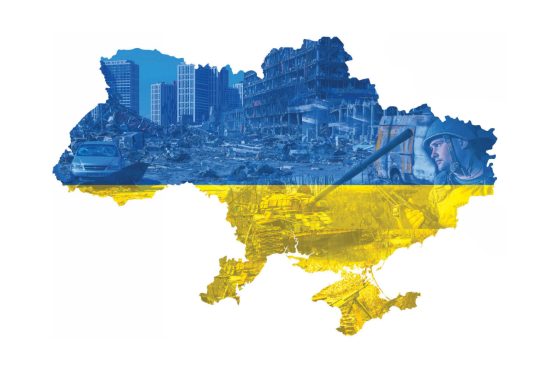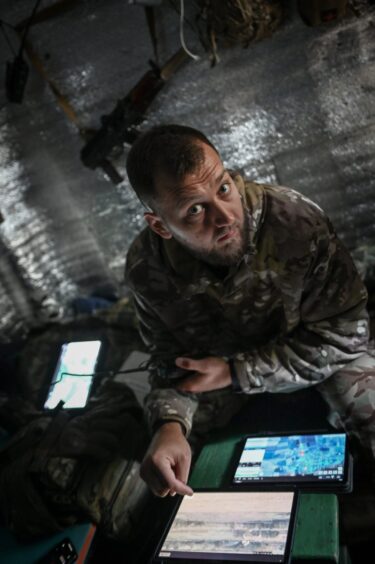
At an artillery position less than four miles away from the Russians, Lieutenant Malko of the Ukrainian 47th Mechanised Brigade spends his days trying to prevent the enemy from capturing the nearly encircled city of Avdiivka.
A veteran of the summer’s counteroffensive in Zaporizhzhia, he is no stranger to relentless combat and brutal losses. But the battle for Avdiivka has proven even more gruelling. The small city, which had a population of 31,000 prior to the invasion, is currently the epicentre of Russia’s war effort. A front-line city since the start of the war nearly 10 years ago, it has since been almost entirely destroyed.
“The frontline is so hard, every moment, every day,” said Malko from his quarters in a house in a village a few miles away from the front. Like most soldiers who spoke to the Sunday Post, Malko only identified himself with his call sign in accordance with standard practice in the Ukrainian Armed Forces.
Malko takes a measure of comfort from the price that the Russians are paying in blood for their sluggish advance. He estimated that around 600 enemy soldiers died every day around Avdiivka during Russia’s intensive push last month. Since the start of November, the line has barely moved at all.
“They are dying probably in the greatest number of all time, due to our concentrated fire,” said Malko, adding that the war had turned into a stalemate.
“None of the ground forces are winning anymore, neither Russian nor Ukrainian.”
‘Stalemate’ as winter approaches
As the year’s prime fighting months in Ukraine give way to the autumn mud season followed by winter, “stalemate” is a word increasingly heard among Ukraine’s defenders. General Valery Zaluzhny, the commander-in chief of all Ukrainian forces, used the word himself in an interview with the Economist earlier this month.
Five months into its counter-offensive, Ukraine has managed to advance just 17km. Russia fought for 10 months around the city of Bakhmut in the east “to take a town six by six kilometres”.
The general told the Economist: “Just like in the First World War we have reached the level of technology that puts us into a stalemate,” he says. The general concludes that it would take a massive technological leap to break the deadlock. “There will most likely be no deep and beautiful breakthrough,” he added.
But while the situation may have reached an overall stalemate, conditions on the front can vary drastically from sector to sector. Fifty miles north of Avdiivka, just south of Bakhmut, Ukraine is still attempting to advance on the city it lost in May.
During a recent visit to a position held by the 28th Mechanised Brigade on a misty autumn morning, the leafy pathways of the trenches smelled of the pine trees that had been cut down to use as supports for the dugouts.
Major Artyom Khodkevich, the commanding officer, compared fighting to that of the trenches of the First World War. Surveillance drones, of course, had replaced biplanes while the communication wire strung through the trenches connected WiFi networks instead of field telephones.
From a small dugout around a mile away from the Russians, Khodkevich watched as his soldiers piloted a quadcopter drone across no man’s land to scout enemy positions. While both sides were exchanging shellfire at a low tempo, the cloudy weather prevented anyone from using high altitude surveillance to identify targets with pinpoint accuracy.
“Once our infantry takes those positions, we start a fire barrage so the enemy isn’t able to counterattack, and then we fire for a few days afterward so they can’t dig in properly,” said Khodkevich.
The major, who struts around the trenches on a prosthetic leg after losing his to a landmine in Kherson last year, takes a cautiously optimistic view of Ukraine’s prospects in the Bakhmut direction.
“We’re advancing not as quickly as we wanted to but we’re moving further and have a plan to not let the enemy take this position,” he said.
With winter coming, Khodkevich hopes that they will keep up the advance. They will continue to push, he said, if the cold does not become too extreme and they receive the proper logistical support. Hand warmers, he said, will be especially needed so they can shoot properly.
The Russians fighting near Bakmut have significantly improved their tactics since last year, he said. Unlike in Avdiivka, where the attackers have resorted to relentless suicide charges, Russian forces near Bakhmut have adopted a far more nimble approach.
“They’re using our tactics mostly, like small assault groups with artillery support,” he said with a mix of frustration and pride.
A hellish normality
For the infantry tasked with storming enemy positions, life takes on a hellish normality.
Along a road just outside the city of Kostyantynivka, a 23-year-old soldier with the callsign Tire Iron has just returned from a mission on the zero line. Their task had been to recover the body of a fallen comrade in noman’s land. They returned empty handed after one of the soldiers took a shrapnel wound to the leg.
Tire Iron spoke excitedly as he deposited weapons onto the asphalt, all trophies taken from dead Russians.
“It’s a regular day for me,” he said with a weary smile. “I almost got killed but who cares?”
Ukrainian fire support officer, callsign Malko, directs artillery fire. Picture: Justin Yau This mission to recover a comrade’s body is a regular day for me. I almost got killed but who cares?

Enjoy the convenience of having The Sunday Post delivered as a digital ePaper straight to your smartphone, tablet or computer.
Subscribe for only £5.49 a month and enjoy all the benefits of the printed paper as a digital replica.
Subscribe © Justin Yau
© Justin Yau